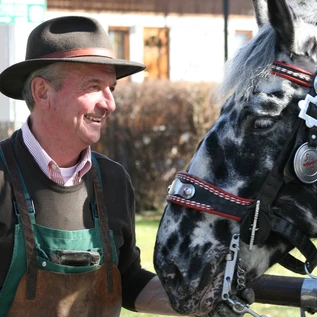Visit us at
Salzburg State Theatre | © knaro.at
Scenes
The world behind those well-trodden boards
The moment you step through the big double doors of the Salzburg State Theatre, you feel as if you have entered a whole different world. Revealing itself behind the neo-Baroque façade is a realm of opera, acting and dance – a colorful cosmos of magic and the imagination. And we were allowed to take a look behind the scenes.
Everything is still quiet in the foyer of the Salzburg State Theatre. The employees in the ticket office are taking phone calls and giving visitors information about the current performance calendar. In fact, the theatre puts on around 400 productions every season, between September and June. During that period, a team of some 400 employees from 35 different countries pulls together to ensure that audiences can escape for a few hours into a parallel world of the imagination. Today however, we are not here to find our seats in the auditorium – this particular time, we have been allowed to peek behind the curtains. In fact, the State Theatre offers a special back-stage tour once a month. Whether the hidden world directly below the stage, the costume department or the make-up room – the long-standing head coordinator of the Salzburg State Theatre, Hans Joachim Erxleben, usually conducts the tour through the different areas, points out interesting details and recounts many a lighthearted anecdote. But we won’t reveal those stories to you here – they achieve their greatest effect when they are told inside this beautiful historic building which was opened on October 1, 1893.
The “Queen of the Night” ascends from below the stage
We begin our tour in a place referred to as the “under-stage” – quasi the belly of the State Theatre. “There are a number of trapdoors in the floor of the stage above our heads through which the actors are able to ascend to the main stage”, Juliane Breyer of the Salzburg State Theatre explains to us, who today happens to be standing in for Mr. Erxleben and is conducting the tour of the building herself. “This often occurs when the character in the production symbolically rises from the underworld, for example – as does the ‘Queen of the Night’ in the ‘Magic Flute’.”
From initial idea to finished set
We now make our way up a narrow staircase to the next floor, where we find ourselves on the main stage. An imposing set occupies almost the entire area. “This is for our current production, ‘Wiener Blut’”, says Juliane. It really is quite an astonishing sight. We move a few steps closer to the opulent scenery in order to give it a personal once-over. “How is a stage set actually created?”, we want to know. “The process basically goes like this”, begins Juliane. “The general director of the theater along with the dramaturgists decide on a specific piece, then agree on the right person to bring it to the stage. In the next step a concept is developed, which includes creating a scale model of the actual set – complete with figurines. This makes it a lot easier to visualize the actual production – including where each of the characters will appear and stand on stage. If everything seems as if it’s going to do the trick, we build a full-size mock-up of the set using simple materials. And if we are satisfied with that, that’s when our workshop in Aigen leaps into action.”
The key component of every production
We now stand in front of the stage manager’s desk – the key technical component of every production, as Juliane explains. It is from here that the stage manager, who is the main coordinator of the production, communicates with the rest of the team, signaling set changes and giving commands. Directly across from the stage manager’s desk is the lighting board. As if by some secret signal, a red spotlight flares up briefly, before fading out again immediately. Behind us we hear a quiet murmuring and a laugh. “A light test”, explains Juliane, smiles and, with a slight motion of her chin, indicates the stage crew who are busy doing their own thing. Overall, you have the feeling that this theatre is one big, colorful and international family. “Yes, theatre people are a special breed”, says Juliane and chuckles. “This kind of work and the hours, which definitely have nothing in common with a regular office routine, create a special kind of bond.”
Finally treading the boards
We continue our stroll through the corridors to the performers’ changing rooms, lightly brushing our fingertips against the velvet-covered walls. The men’s and women’s changing rooms, incidentally, are kept strictly separate. “That’s important so as to protect the personal privacy of the actors”, Juliane explains to us. “After all, when they’re changing they are often scantily dressed.” We stop next to a private changing room, where the name of the actor is mounted on the door. We try to imagine how the actor takes a last look in the big mirror, perfectly adjusts a stray strand of hair and perhaps exchanges a few words with one of the costume attendants. And then, it’s time for them to stride out onto the stage and wait with baited breath until the curtain rises. After having been given this opportunity to take a look at all the goings-on behind the curtains, we can’t wait until we are fortunate enough to take our seats once again out in front of the curtains here at the Salzburg State Theatre.














